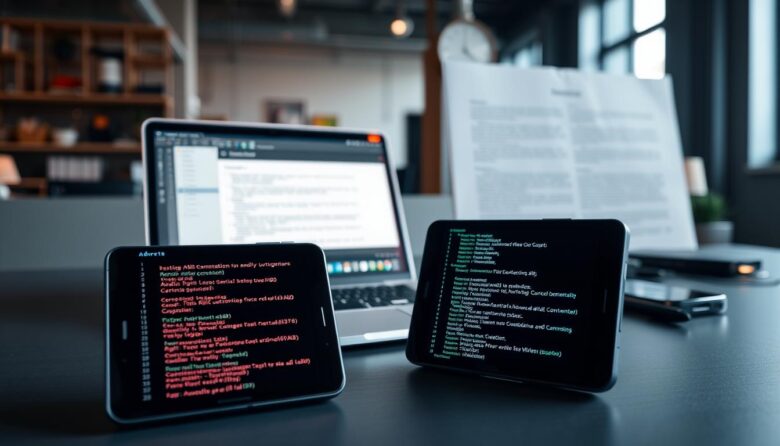Advanced users seeking deeper control over their mobile experience often turn to specialized tools. A command-line interface bridges the gap between standard settings and system-level modifications, offering capabilities far beyond typical user interfaces.
This guide explores critical techniques for interacting with mobile devices through a computer. Developers and enthusiasts rely on these methods to install custom software, debug performance issues, or unlock hidden features. The included protocols enable precise adjustments that transform how a gadget operates.
Mastering these tools provides three core advantages: direct access to restricted functions, streamlined troubleshooting workflows, and safer modification processes. Professionals frequently use them to bypass manufacturer limitations or optimize hardware performance for specific tasks.
While the learning curve might seem steep initially, even intermediate users can benefit from learning foundational operations. The upcoming examples focus on practical applications that deliver immediate value, from recovering locked devices to managing app permissions at scale.
Understanding these strategies empowers individuals to customize their tech experience while maintaining system stability. Whether modifying interface elements or diagnosing complex errors, these methods serve as the backbone for advanced mobile management.
Overview of ADB and Its Role in Android Mastery
At the core of Android customization lies a powerful duo of utilities connecting computers to mobile hardware. These protocols enable interactions that go far beyond standard settings menus, offering direct communication with a device’s operating system.
What Is ADB and Fastboot?
The Android Debug Bridge serves as a critical link between devices and computers through command-line interfaces. Developers use this tool to send instructions, transfer files, and debug software issues remotely. Its companion protocol, Fastboot, activates during bootloader mode to modify system partitions and firmware components.
These utilities work together to handle tasks like installing unsigned apps or recovering bricked devices. While the debug bridge manages active systems, Fastboot operates at a lower level for hardware-related adjustments.
Why Power Users Rely on These Tools
Technical enthusiasts value the unrestricted access these solutions provide. They bypass manufacturer restrictions, enabling modifications unavailable through standard interfaces. This access proves essential for testing beta software, optimizing performance, or implementing custom ROMs.
Professional developers particularly benefit from the debug bridge’s ability to manage multiple devices simultaneously. The toolset transforms ordinary smartphones into adaptable platforms for experimentation and innovation.
Introducing the Best ADB Commands Android Users Must Know
Mastering mobile device customization requires precise tools that bridge technical gaps between standard interfaces and advanced operations. These critical protocols enable direct communication with system layers, unlocking capabilities ordinary users rarely access.
The adb devices function verifies active connections, serving as the foundation for all subsequent tasks. When using adb, this command confirms proper linkage before executing sensitive operations. Pair it with adb push or pull to transfer files between machines and gadgets seamlessly.
Rebooting into specialized modes becomes straightforward with the bootloader access protocol. This feature allows hardware-level adjustments, including firmware updates or partition modifications. For app management, the installation tool bypasses traditional store restrictions, enabling side-loaded software deployment.
Terminal access via shell commands provides granular control over system processes. Professionals leverage this solution to modify permissions, debug errors, or analyze real-time logs. Combined with recovery-flashing capabilities, these tools form a comprehensive toolkit for transformative device adjustments.
Each protocol addresses specific needs while maintaining system integrity. From basic connectivity checks to complex firmware changes, these functions deliver professional-grade results without compromising stability.
Managing Connected Devices with ADB
Efficient device management forms the backbone of successful system interactions through command-line tools. Proper connection protocols ensure accurate execution of operations while maintaining control over hardware configurations.
Using the adb devices Command
The essential starting point for any session involves verifying active connections. Entering “adb devices” displays all linked hardware, showing serial numbers and authorization status. This immediate feedback confirms whether your computer recognizes each android device properly.
Developers frequently run this check before pushing files or installing software. Connection issues often surface here, allowing quick troubleshooting of USB debugging settings or driver conflicts.
Handling Multiple Devices Efficiently
Testing environments often require simultaneous management of several gadgets. When multiple entries appear in the device list, specify targets using their unique serial identifier: “adb -s ABC123 shell”. This prevents accidental changes to unintended hardware.
The precise targeting system proves vital when updating specific models or comparing performance across versions. Professionals use this method to maintain organized workflows during large-scale app evaluations or beta tests.
For example, a developer might transfer different APK versions to separate android devices using distinct serial numbers. This approach eliminates confusion while enabling parallel experimentation across multiple configurations.
Rebooting, Bootloader, and Recovery Access
Direct control over device states unlocks hidden potential for tech enthusiasts. Specialized reboot protocols enable access to restricted environments where system-level adjustments become possible. These methods provide safer pathways for modifications compared to manual hardware manipulation.
adb reboot bootloader Explained
Entering “adb reboot bootloader” initiates a targeted restart into firmware management mode. This state allows flashing custom partitions, unlocking bootloaders, or modifying core software components. Professionals rely on this command to bypass factory limitations and implement performance enhancements.
Transitioning to Recovery Mode with Commands
The “adb reboot recovery” directive shifts devices into a maintenance environment. Recovery mode supports critical tasks like cache wipes, factory resets, and manual system updates. Users often activate this mode to install custom software packages or troubleshoot persistent errors without disrupting primary operations.
Both protocols prioritize stability during sensitive procedures. Bootloader access handles foundational changes, while recovery mode focuses on repairs and updates. Together, they form a secure framework for advanced modifications across Android-based hardware.
File Transfers and Data Management via ADB
Effective tech workflows demand robust solutions for moving information across platforms. Command-line protocols provide unmatched precision when managing digital assets between systems, particularly for specialized tasks requiring direct access.
Utilizing adb push and adb pull
The adb push operation transfers files from a computer to connected hardware. Users specify source and destination paths: adb push D:\image.png /sdcard. This method proves invaluable for deploying configuration files or media assets to restricted directories.
Reverse the process with adb pull to extract logs, backups, or system data. The syntax adb pull /sdcard/backup_April.tar D:\Backup securely retrieves information without intermediary storage. Both functions bypass traditional transfer methods, maintaining data integrity during critical operations.
These protocols shine in development scenarios. Engineers synchronize test builds across devices using automated scripts. Security teams migrate sensitive configurations without exposing files to cloud platforms. The command-line approach enables batch processing for repetitive data tasks.
System administrators leverage these tools for large-scale deployments. Moving firmware updates or diagnostic packages becomes streamlined through direct file manipulation. Granular control over permissions ensures compliance with enterprise security policies during transfers.
Installing Apps and APKs on Android Devices
Direct software deployment bypasses traditional installation barriers, offering granular control over application distribution. This method proves indispensable for testing unreleased builds or distributing custom tools outside official channels.
Understanding the adb install Command
The adb install protocol transfers APK files from computers to gadgets using precise syntax. Basic execution involves typing adb install app.apk, which pushes the package to connected hardware. Developers frequently add flags like -r to overwrite existing apps during updates or -t for test-only builds.
Complex scenarios require advanced parameters. Multi-APK installations use install-multiple for split packages within one app. Separate software bundles deploy via install-multi-package, enabling simultaneous updates across different tools. These options streamline workflows for teams managing large-scale app deployments.
Removing software follows similar precision. The adb uninstall function deletes apps by their unique package identifier, such as com.example.tool. This approach helps maintain clean testing environments by eliminating residual files from previous iterations.
Enterprise environments particularly benefit from these protocols. System administrators deploy company-specific apps across hundreds of devices without manual intervention. QA teams automate version testing by cycling through multiple APK builds hourly, ensuring compatibility before public releases.
Gaining Shell Access for Advanced Customization
Technical customization reaches its peak potential through direct system communication channels. The adb shell protocol unlocks a Linux terminal environment within mobile hardware, granting unparalleled control over software behavior and configurations.
This interface bridges desktop computers and gadget internals through precise command execution. Users initiate sessions by typing “adb shell” in their terminal, receiving a prompt that mirrors the device’s native command-line environment.
Exploring the adb shell Interface
The shell environment enables real-time process monitoring and file system navigation. Developers modify permissions, terminate unresponsive services, or extract diagnostic logs using native Linux utilities. These operations occur directly on the hardware’s processor, bypassing graphical interfaces entirely.
System administrators leverage this access to configure network parameters or manage user accounts across multiple devices. Automation scripts benefit from direct interaction with core utilities, enabling scheduled maintenance tasks without manual intervention.
Advanced troubleshooting becomes streamlined through shell commands. Professionals analyze memory usage patterns, test hardware components, and optimize performance metrics through targeted terminal inputs. This level of control transforms standard gadgets into adaptable platforms for experimentation and refinement.
Flashing Custom Recoveries and ROMs
Transforming gadget capabilities requires stepping beyond factory limitations. Custom firmware installation represents the pinnacle of system modification, enabling users to reimagine their hardware’s potential through tailored software environments.
fastboot flash recovery Insights
The fastboot flash recovery protocol replaces stock restoration tools with enhanced alternatives. Using syntax like fastboot flash recovery twrp.img, tech enthusiasts deploy solutions like Team Win Recovery Project (TWRP) for advanced control. This process demands unlocked bootloaders and careful image verification to prevent system instability.
Custom recovery systems unlock critical functions unavailable in standard settings. Professionals use these tools to create full-system backups, modify partitions, and install alternative operating systems. The flexibility proves invaluable when testing experimental software or recovering from critical errors.
While powerful, this way of modifying devices carries risks. Bootloader unlocking often voids warranties and requires technical preparation. Developers recommend researching hardware compatibility and maintaining emergency restore files before proceeding with permanent changes.



